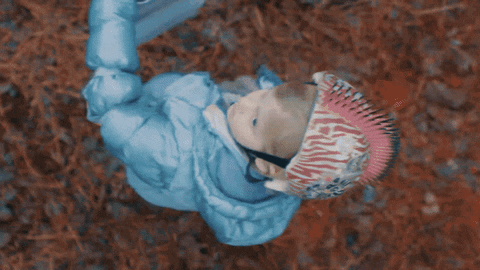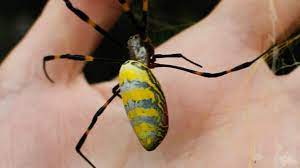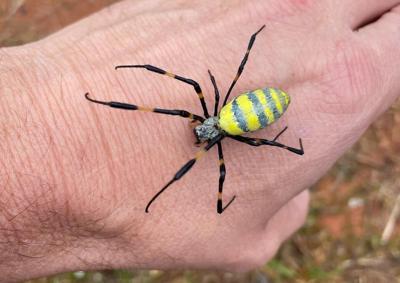
Posted on 03/08/2022 2:24:14 PM PST by nickcarraway
The authors say the arachnids are harmless to people and pets and may even eat pests like stink bugs
Last year in Georgia, the non-native Joro spider population exploded. Golden webs draped porches, powerlines and mailboxes across at least 25 counties in the state, per the Hexapod Herald’s Michele Hatcher.
“I have several hundred, and they actually make the place look spooky with all the messy webs—like a scene out of 'Arachnophobia,'” entomologist Will Hudson of the University of Georgia Extension told the Herald last fall.
The spiders are large and eye-catching, about the size of a human adult’s palm, with bright yellow, blue and red coloration.
And they can fly; these arachnids form parachutes out of their webs and can travel up to 50 to 100 miles through the wind, per the University of Georgia Extension.
With the Joros quickly conquering the state, University of Georgia researchers Andrew Davis and Benjamin Frick wondered how far north the spiders would spread, writes Carrie Arnold for National Geographic. Their new study, published in Physiological Entomology, found that Joro spiders can survive in colder temperatures, making it likely that the species will take over much of the East Coast.
Spider webs Joro webs UGA Today Researchers compared the Joro spider to the golden silk spider, a species in the same genus that has not expanded beyond the southeast, per the study. They also looked at data collected on iNaturalist, a citizen science website and app that collects data on the location, species and time of a wildlife sighting. Then, the researchers measured traits like metabolic rates, heart rate and survival during below-freezing temperatures to help predict female spiders’ tolerance to cold.
Compared to the golden silk spider, Joros have a 77 percent higher heart rate when exposed to low temperatures, have double the rate of metabolism and are more likely to survive a brief freeze, per the study. The spiders also have a shorter season, meaning they can complete their life cycle within a narrower period.
“It looks like the Joros could probably survive throughout most of the Eastern Seaboard here, which is pretty sobering,” Davis says in a statement.
Some scientists say East Coasters have nothing to worry about—the spiders haven’t shown any signs of disturbing local ecosystems, they don’t harm humans, and they even eat pests like stink bugs, writes the Associated Press’ Sudhin Thanawala.
“This is wonderful. This is exciting. Spiders are our friends,” Nancy Hinkle, an entomologist at the University of Georgia, told the wire last year. “They are out there catching all the pests we don’t want around our home.”
But not all scientists are as enthusiastic.
“You really don’t know if this is displacing native stuff or not,” Dave Coyle, a professor of forest health and invasive species for Clemson University tells Fox Carolina’s Amanda Shaw. “So personally, I’m not prepared to say that it’s not harmful. But I can say that it’s not harmful to people or pets.”
Joro spiders are native to Japan. They arrived in the United States around 2013, likely riding on shipping containers, per the statement.
“There’s really no reason to go around actively squishing them,” Frick says in the statement. “Humans are at the root of their invasion. Don’t blame the Joro spider.”
Margaret Osborne is a freelance journalist based in the southwestern U.S. Her work has appeared in the Sag Harbor Express and has aired on WSHU Public Radio.
“Spiders are our friends.”
Don’t go out drinking with them.
Mean drunks.
They eat stink bugs...they can’t be all bad.
Great! Another lockdown and mandated anti-spider vaxes.
Murder Hornets were a huge disappointment.
Yes! They really eat stink bugs?
Do they make silk too. Maybe they eat the Japanese Beatles too.
This is going to SERIOUSLY freak out a LOT of people.

/https://tf-cmsv2-smithsonianmag-media.s3.amazonaws.com/filer_public/2c/0e/2c0ecf11-d61c-4394-adf8-53ad7db35f3f/img_3308-1152x1536.jpg)


Smashable.
I ignored them up until I found about 10 large females (and some males) with webs established in about a 30sf rectangular area. Trust me, you cannot co-exist with these spiders.
After considering various means to kill them (salt guns, air gun, shocking devices) I settled on a slingshot loaded with a pinch of clean kitty litter. It's very effective, safe for your property, and safe for your yard. Cheap too. Like a little beehive round for these bastards. I suggest you kill every one you see.
This year I am considering using a pesticide. Can any experts out there suggest what I could use safely? I recall reading that the Joro spider lays eggs in the ground. Please help! Lol.
Think of how their parents felt.
They aren’t even as good as manslaughter wasps
I look forward to collecting spider parachutes!
Are you sure this is a legitimate article about nature? I didn’t see “climate change” anywhere in the text
Fund..something else to worry about.
Disclaimer: Opinions posted on Free Republic are those of the individual posters and do not necessarily represent the opinion of Free Republic or its management. All materials posted herein are protected by copyright law and the exemption for fair use of copyrighted works.